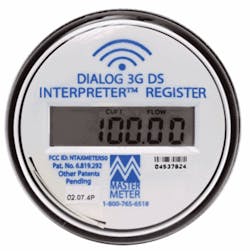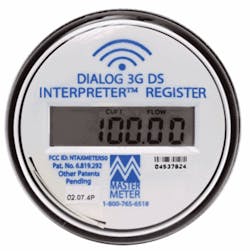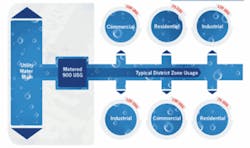City of Ottawa Implements Innovative AMR Pilot Program To Curb Distribution System Leaks
The City of Ottawa is using innovative automatic meter reading (AMR) technology to enhance and quantify data gleaned from district metering areas. Ottawa's Public Works and Services Department hopes the new AMR pilot program, the first of its kind in the city, will provide valuable insight into local water consumption patterns and establish guidelines that can be applied to monitoring non-AMR equipped district metering areas in Ottawa.
The Drinking Water Services Division is responsible for managing and distributing water to close to 750,000 residents and businesses. It is one of the largest water systems in Ontario under a single authority. There are over 195,000 meters installed throughout the city.
The city's Utility Services Branch of the Department of Public Works initiated the AMR pilot program. Responsible for the city's water loss and leak detection efforts, the Branch was looking to improve upon their ability to monitor leaks within the water distribution system.
Monitoring district metered areas (DMA) has become the preferred standard for proactive distribution system leak detection. First gaining wide implementation in the UK and Europe, DMAs are now being adopted by North American utilities.
What are DMAs
A DMA consists of an isolated water distribution zone behind a single metered inlet or, in some cases, multiple metered inlets. The objective of the DMA is to measure the total volume of water flowing into the zone and compare that volume against legitimate water consumption within the zone. Subtracting legitimate consumption from the total flow into the zone provides the exact real loss within the distribution system.
Utilities establish normal flow ranges for a given DMA by monitoring night flows, typically between 2 a.m. and 4 a.m.
Monitoring night flows within DMAs has proven effective in helping to identify unreported bursts and other significant losses; however, the City of Ottawa and its research partners felt the process relied too heavily upon assumptions of legitimate use to provide accurate numbers related to real losses.
Real losses are the combination of unavoidable background losses and leakage. Individually, the leaks contributing to unavoidable background losses are often too small to measure and not economical to repair. These can be accurately estimated based on system characteristics. Determining which portion of night flow comes from legitimate use, as opposed to loss, has not always been an exact science for utilities. Ottawa hopes to change this.
The city's project engineers created a design for their pilot system that would help clearly define their real losses by measuring actual consumption at every metered point in the DMA. Subtracting confirmed metered use from the total flow metered entering the zone will provide exact indication of leakage in the distribution system. This eliminates any error in calculation that may occur when using standard legitimate use assumptions established by European experts in the water loss control field. It is not that such use assumptions are inherently wrong, but Ottawa intends to determine whether these consumption pattern assumptions, many of which are dated and were developed based on usage pattern in Europe, are still viable or representative of usage occurring specifically in Ottawa.
Pilot Project
Ottawa engineers began developing their pilot plan in early 2006. In addition to seeking actual night consumption numbers, engineers hope to use the system to generate daily consumption patterns, identify effects of implemented water efficiency measure, and test the reliability of meters.
Engineers met early with AMR vendors outlining the goals for the project. The equipment requirements called for high-resolution flow measurement (1 liter), synchronized read capabilities, and the ability to remotely transfer read data.
Ottawa issued a request for proposal and met with several equipment vendors, evaluating how well each could meet their requirements. The city narrowed their list based on the technical capabilities of the equipment providers, then looked for the most cost-effective solution before awarding the contract.
Master Meter was selected to provide the AMR read technology. The company's DIALOG 3G® meters and registers incorporate a real time clock (RTC) capable of providing synchronized reads at distinct time steps. This was critical for the proposed system to capture night-time usage consumption. The pilot project required an AMR upgrade for dozens of large meters operating within the system. Rather than replace the entire meter, Ottawa was able to replace the original registers on the large meters with Master Meter's universal AMR register, the Interpreter. The ability to retrofit existing infrastructure represented a significant savings in both the time and costs required for the AMR rollout.
Pilot Area
The area selected for the pilot program measures approximately one square kilometer, accounting for roughly half of an established small pressure zone. Within the pilot DMA, there are 937 metered connections consisting of 900 residential properties, with the remainder of the properties commercial or industrial.
Project Rollout
The rollout for the pilot program began in the Spring of 2007. Prior to the pilot program all properties within the zone were fitted with standard billing water meters. Reads were collected from exterior mounted touch pads. During the AMR rollout these meters were either replaced or upgraded with 3G meters and registers. The new meters can be quickly read remotely by a passing utility vehicle fitted with a small wireless transceiver.
To enable night flow consumption testing, the real-time clock in each register was set to record reads at 2 a.m. and 4 a.m. Synchronized readings are required for the accurate measure of consumption within the two hour testing period.
All 937 meters in the DMA can be read within one and a half hours. The resulting reads provide accurate measure of all of the flow into the zone and customer consumption within the two hour testing period.
Testing Underway
The AMR pilot project rollout in Ottawa is complete. The city is currently undergoing night flow testing, establishing usage patterns and evaluating all the new data being captured. It is evaluating the new AMR system as a whole, including areas beyond leak management.
In accordance with the overall project goals it is looking to the AMR system to help establish daily consumption patterns, and to identify the effects of water efficiency measures being implemented.
The AMR system is being used to capture monthly billing data from customers in the area. The newly installed 3G meters provide data logging capabilities that are helping define customer usage patterns. The utility can program the meters to take and store reads every 15 minutes at customer locations.
This information provides a very detailed look at the amount of water being used at specific times of the day. The water billing group is using this information to address customer billing inquiries. With this information, the department can help customers identify specific dates and times of high consumption at their property .WW
For further information, contact Ian MacLeod, e-mail: [email protected]


